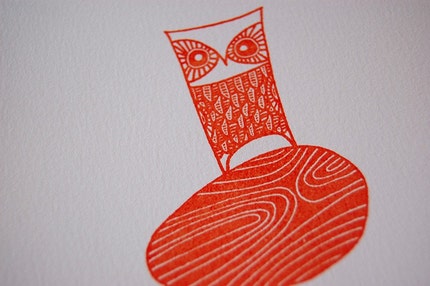
Isn't he lovely? I just bought this from Sugarloop's etsy shop. She really is one of my favourite Etsy sellers (for two reasons, one we're about to get to, the other because of her artwork). Oh, and the price! This came in at the ridiculous price of $20 Australian icluding shipping! Not that I'm complaining about a bargain. I kept umm-ing and ahh-ing over which of her prints to buy, then the one I liked would sell out, so when this one was listed this morning I didn't hesitate over the fact that nothing else in my house was orange, I snapped it up for its fab design. And given the size, I think it will fit into those delightfully low-price Ikea frames that are designed to hold Ikea postcards.
Now, the other reason I like Sugarloop's Etsy shop is to do with 'prints'. Many artists on Etsy sell 'prints'. Unfortunately, from a fine art perspective, what they actually sell is reproductions - a high quality copy (scanned and colour-printed, generally) of an original of their artwork, made in an unlimited/ unnumbered quantity*, sometimes signed. A print, technically, is a piece of art produced in a limited edition multiple, numbered and signed. There's nothing wrong with selling reproductions, but it makes it nearly impossible for those looking for prints to find them, short of searching individually for 'etching', 'linocut', 'gocco', 'screenprint', etc. I was lucky to stumble across Sugarloop.
I wish the terminology on Etsy was more precise, so as to separate out original artworks (prints) from the reproductions.
And many of the artists selling prints made from more accessible methods (gocco, screenprint, photography) don't number their work. I think this is a pity, as it prevents the work being regarded as 'real', collectable art in the traditional sense. When I print-made (what an excellent past-tense) my teacher used to make me destroy the plates/ screens after I completed an edition. And I was just a nobody churning out art to get a grade. He said it was a good habit to get into (and as a printmaker himself, I guess he would know). I personally won't buy a print that isn't numbered. I want to know how many other out there will have a piece of art like mine. Judging by Sugarloop's sucess, limiting the number of prints you make doesn't hurt business. She sells in sets of 80 to 100, generally, but there's no reason that editions can't be bigger. I have other etchings that are from editions of 500 and 1500 respectively. And you don't actually have to make all 1500 in one go. It's just a commitment that you won't make more than that number. And small alterations (hand-colouring part; or changing the ink colour) can justify a new edition.
Perhaps that's old fashioned of me, expecting editions to be limited. Are there other perspectives that defend not numbering works?
* Some reproductions are sold in limited editions too, actually. Banksy, for instance, sells limited edition reproductions (in the form of posters) that fetch high prices. Jury's out on this for me. I have no problem with the practice of selling limited edition repros, but I don't think I'll ever buy one personally. Maybe I'm just an art snob.
1 comment:
Ah, the reproduction vs. the original debate..
I personally don't have a problem with reproductions but that's probably from having too much Baudrillard crammed into my head at school.
I agree though that there is something pretty cool about having a limited edition print in your hands, expecially if it's by an artist you enjoy.
Post a Comment